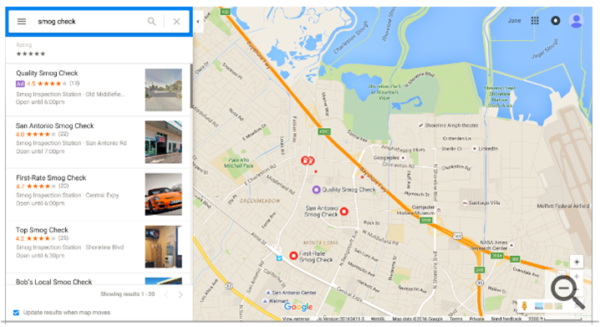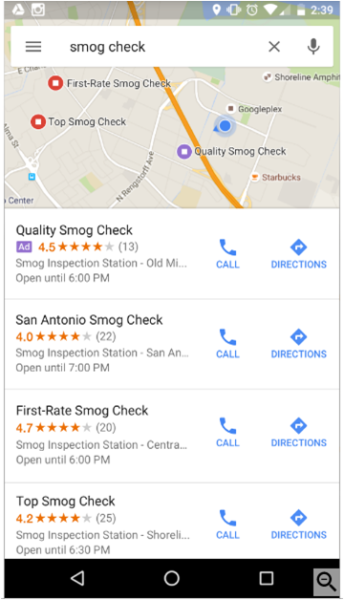
May 25, 2016: On May 24th, Google announced that advertisers will soon have a chance to place local search ads directly onto Google Maps, a service that to date has been ad-free. The announcement was made at a physical press conference in San Francisco and also on Google’s Adwords Blog. Technical documentation for the new Maps-based ads also appeared in Google’s Support area.
Where will they appear?
Ads will appear on both mobile and desktop devices and will show in two places within Maps: in the search results list appearing below the search box, and on the actual map. In the example below, a purple icon appears in the results list and a purple “pin” appears on the map.

On mobile devices, there’s less real estate available for photos in the area below the search box, but otherwise the presentation is identical to the desktop layout:

Advertisers can add “Call” and “Directions” buttons to their ads. When the latter is clicked, Maps will create a navigational path for the user to visit the advertiser’s real-world location. Users can also “tap” the ad, which will cause additional information, for example store hours and reviews, to appear.
Who can run them?
Adwords advertisers in good standing can begin targeting Maps users if they have:
- Location extensions enabled in their accounts.
- A valid listing in Google My Business.
- Enabled location targeting in Adwords and set locational bids.
- Have selected keywords used by the Maps user in his/her query.
When will they begin running?
According to press reports, ads on Maps will begin rolling out later this year.
Why is this happening now?
Google and Facebook are fighting a pitched war for brand ad dollars chasing mobile users. Maps – which has more than a billion users – is a popular and largely monetized area of Google. Maps is one of the most useful Google-provided features on mobile devices, Facebook has no equivalent, and Google apparently believes that users will accept ads in the Maps interface as both useful and relevant.
Adding ads to Maps makes sense from an anti-ad blocking perspective as well. Ad blocking is proving to be an enormous challenge to the ad tech industry. Some 200 million users employ ad blocking software worldwide, and these people tend to trend higher in terms of income, tech readiness, and other desirable demographics. Google has announced that users will not be able to disable ads in the Maps interface, which means that in order to use Maps, they’ll be forced to view ads.
The value to advertisers
Being able to target Google Maps users provides marketers with a new set of geo-segmenting tools that many will find attractive and compelling. As Google points out, fully a third of mobile searchers are related to location. Many of these searches have a high level of commercial intent, which means that conversion rates may be satisfactory in many use cases. And many sophisticated Adwords users already use location extensions, which means that when the new system is ready, demand for it – and click prices – will likely be high.
While some might object to the idea that Maps – among the most useful utilities provided by Google – will soon be overrun with virtual billboards, many consumers will likely welcome them, because they are relatively unobtrusive and relevant in the context the Maps UI. And because they can’t be turned off, they can’t be ignored or blocked.
Which means that opening up Maps to ads is a very smart move on Google’s part.
- 10 Mistakes to Avoid When Using QR Codes for Marketing - September 20, 2023
- Kevin Lee on How AI Changes the SEO Landscape - August 31, 2023
- The Power of Compound Marketing: Kevin Lee Presents @ 1MediaWorld 2023 Global Conference - March 7, 2023
